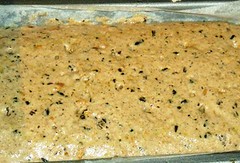 Rye Sourdough Black Breads with a Hot Grain Soaker
Rye Sourdough Black Breads with a Hot Grain Soaker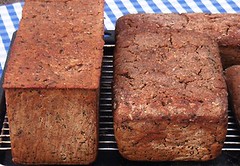
I recently purchased 2 types of malted grain prepared for the purpose, primarily, of brewing; in other words gently crushed for easy mashing to extract sugar.
One of these grains is barley, the other is from rye; details as follows:
- Rauchmalz – Bavarian Smoked Malted Barley, EBC 10. Apparently this is highly prized, it has been very lightly prepared, so its colour grade is very low down the spectrum.
- Roasted Rye Malt, EBC 800….very dark indeed.
Both of these come from Germany.
Additionally I had some Organic Rye Flakes left in the store cupboard which needed using up.
I wanted some large panned loaves to go in the freezer for a “Wine and Cheese” Night organised at Ingram Hall, nearby on 5th December. This arrangement came out of the sales I made at the Powburn Show in August. See:
http://www.thefreshloaf.com/node/24576/%E2%80%9Cnine-show%E2%80%9D
I refreshed my rye sour from 80g in stock, through 3 feeds to end up with just short of 2kg to use to make these breads. I prepared a hot soaker the night before and then added this to the sour culture to make the “sponge” demanded in the 3 stage Russian process.
I made 2 large tinned loaves, one small one, and had just a little paste left to make another really small loaf.
Recipe and formula details are shown below:
Material/Stage | Formula [% of flour] | Recipe [grams] |
1a. “Rye Sourdough” |
|
|
Bacheldre Organic Dark Rye Flour | 30 | 675 |
Water | 50 | 1125 |
TOTAL | 80 | 1800 |
|
|
|
1b. “Hot Soaker” |
|
|
Rauchmalz | 5 | 112.5 |
Roasted Rye Malt | 5 | 112.5 |
Organic Rye Flakes | 5 | 112.5 |
Bacheldre Organic Dark Rye Flour | 5 | 112.5 |
Salt | 0.2 | 4.5 |
Boiling Water | 35 | 787.5 |
TOTAL | 55.2 | 1242 |
|
|
|
2. “Sponge” |
|
|
Rye Sourdough [from 1a. above] | 80 | 1800 |
Hot Soaker [from 1b. above] | 55.2 | 1242 |
TOTAL | 135.2 | 3042 |
3. “Final Paste” |
|
|
“Sponge” [from 2 above] | 135.2 | 3042 |
Bacheldre Organic Dark Rye Flour | 26.67 | 600 |
Carrs “Special CC” Strong White Flour | 23.33 | 525 |
Salt | 1.33 | 30 |
TOTAL | 186.53 | 4197 |
|
|
|
Overall % pre-fermented flour | 30 [sour] + 20 [sponge] = 50 | - |
Overall % hydration | 85 | - |
FACTOR | 22.5 | - |
Method:
- Refresh the Rye Sourdough over 3 refreshments beginning with stock base of 80g.
- Make the Hot Soaker 4 hours before the full sour has been built. To do this, pour the boiling water onto all the other ingredients and stir well to mix. Leave covered to cool to room temperature.
- Make the Sponge by combining the soaker with the full sour required. Return the spare rye sour to stock. Cover the Sponge and leave to ferment for 4 hours in a warm place [28°C is ideal].
- Add the remaining flours plus the salt to the Sponge and mix to form the Final Paste.
- Bulk ferment, covered for one hour.
- Prepare the tins by lining the walls neatly with silicone paper. I made one Pullman Pan scaled at 2000g, one large panned loaf at 1200g, and one small at 600g. I made the remainder up into a small loaf [c.397g] and baked it later. I docked the 2 panned loaves without lids, using a wetted probe thermometer needle.
- Bake in an Electric oven at 160°C using fan assistance for convection, with steady steam supply. The small loaf baked one hour, large loaf 1 hour 40 minutes, and the Pullman Pan took 2 hours.
- Cool the loaves thoroughly on wires.
Hot Soaker Soaker to mix with sour for sponge Active Sponge ready to mix final paste
Mixed Final Paste Full proof in different pans, ready to bake
The flavour of this bread is impressive. There is obvious sourness from the Rye Sourdough, making up 30% of the flour mix. The malty flavour is wonderful, and complex too, thanks to both the smoked malt, and the very dark roasted rye. It lingers on the palate for ages reminding just how tasty the bread really is. The use of the “Sponge” makes for a great combination of the sweet and sour, and the ferment was alive. One hour in bulk, followed by 1½ hours final proof is all that was required before the breads were ready to bake off.
It is the weekly trip to Leeds first thing tomorrow, with hot/boiled water pastry and savoury short paste featuring early on, followed by a day with a Level 2 group working on production in the morning, then an afternoon’s theory class to follow.
Photographs below:
All good wishes
Andy
- ananda's Blog
- Log in or register to post comments


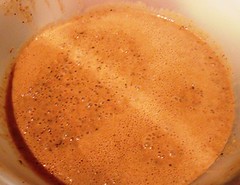


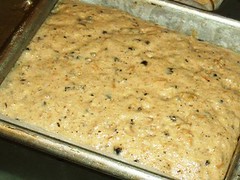


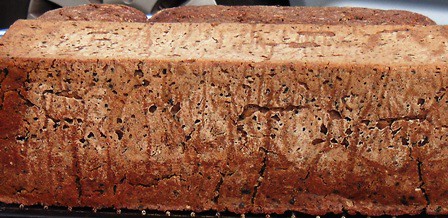



The texture and color of your loaves makes me imagine how flavorful they must be. I have started to read Bread Matters which you recommended. -Varda
Thank you for your generous comments Varda.
I took the photographs outside 2 or 3 hours after baking the loaves. By late evening the crumb was really darkening when I cut into the small loaf to make sandwiches for my days in Leeds. The crumb is as moist as it can be.
I really hope you get plenty of insight from what Andrew Whitley has to say in his book.
All good wishes
Andy
Hi Andy,
Well I think whoever is choosing the cheese to go with this bread for the 'Wine & Cheese Night' better pick one with enough flavour to match the big taste of your loaves. It's good to see your breads have gained further attention from the market show last August, and hopefully there will be much more to come in the months ahead.
From the ingredients and process you've employed I'd have been shocked if you'd said they had anything less than impressive flavour. You should already know what a fan I am of your rye breads and their crumb, but these loafs look especially tasty with the dark flecks of... roasted rye malt I'm assuming. One of the striking parts of this bread for me is the level, even cornered shape of the baked loaf. I have a fine appreciation for the skill needed to achieve this degree of uniformity with a rye paste of this ratio and hydration. Brilliant work Andy!
Have a good week my friend and all the best,
Franko
Hi Franko,
The cheese comes from a small dairy farm, Doddingtons, just 7 miles up the road from where we live. They also do ice cream which is magnificent. The top cheese they make is called "Berwick Edge". It has the appearance of a first class Aged Gouda. However, it has a flavour profile to match the very best Parmigiano! It's offered with oatcakes as a last course at our favourite pub right next to the sea; a haven on the amazing Northumberland coast.
Regarding shaping, the technique for the Pullman Pan is not easy to grasp. When I was at Village Bakery, Andrew whitley was always keen to encourage us to adopt good technique for scaling and panning the Rye loaves. Once the piece had been accurately scaled, and using judiciously wetted hands, we had to pick up the whole piece, smooth and shape to the size of the tin, and drop it cleanly into the tin. That was it! However, it is impossible to do this with a piece that weighs 2kg! I have to drop it into the pan in 3 or 4 pieces and make sure it is spread and amalgamated properly first. Then I smooth off the top with a wet plastic scraper.
Yes, the dark flecks are Roasted Rye; you can also see the pale flecks which are pieces of the Rauchsmalt.
Thank you for your ever generous words of support, it is really good to hear from you
Very best wishes
Andy
Hi Andy,
Beautiful loaves!
Can you tell me the water and flour amount you add to your 80g stored sour when doing the builds that lead up to the final 'paste'?
And a vocabulary lesson....I notice with your rye loaves you always use the word 'paste' instead of the word dough....Can you tell me why that word is used?
Thanks,
Janet
Hi Janet,
I am afraid I didn't keep a record of the refreshment details you ask for. I know I refreshed 3 times, but beyond that, I didn't have time to record all the details. I am reluctant to post them as gospel to be honest. Expecting to copy my refreshment regime with totally different flour, temperature and environmental considerations and end up with the same results is unrealistic. If I have noted down the detail, I only ever publish it as a guide for help.
I use the word "paste" quite deliberately, although I am not sure it is absolutely correct. What I am sure about is that using the word "dough" would be wholly wrong, as the mass resulting from combining rye flour and water betrays none of the properties associated with elastic, or extensible dough. If it does, then the hydration is far too low and the mixing employed is wrong; the hydration here is 85%, and the resulting paste will take on none of the qualities you would expect of a wet wheat-based dough such as Ciabatta during the bench proof. I use paste as a general term for flour in a moistened medium, although the rye paste bears little similarity to shortpaste, let alone puff paste!
Thank you for your kind words and your questions
Best wishes
Andy
and be as close as possible to the truth! :-) Except for the taste, of course.
Nice bread, Andy. The malt gave an unexpected reddish coloring to the paste, if I'm not mistaken. I've been struggling for years to get a perfectly square form, but I still get unwatchable rounded stuff.
Didn't you grind the malt? I see speckles in the crumb.
I know how lovely is the persistence of the sweet-sour taste of this kind of bread. When I'm in a hurry I have lunch only with rye bread and water (like a convict!) in order not to spoil the taste of the bread with something else.
A perfect pullman loaf.
I find your rye bakes fascinating and can only imagine how well these must taste with all those malted grains.
How are you choosing your malted grains? I take it they are from brewing retailers.
Cheers, Phil
Hi Phil,
Many thanks for the compliment. I made some notes above to Franko regarding shapoing for the pans. The other critical factor is judgement of proof. The activity level in the final paste was ideal, with use of the additional sponge process really helping here. Relatively short bulk and final proof times have always worked best for me with this type of bread. All the complex fermentation takes place in the earlier stages.
The grain was bought online. Interestingly enough, the original suppliers are based in Cleckheaton in West Yorkshire. I mention this only because it is my family's home town!
Very good to hear from you
Best wishes
Andy
Hi Andy
Very nice indeed and one of things i still have to try, hot soak that is. I have been eyeing off the grains available at the local brew shop and intend trying some soon. I did a rye the other day using some of my home brew dark ale in the liquid addition it proved to be rather slow but i put that down to taking the sour dough culture straight from the fridge without a revitalising feed or two, as it was getting close to knock off time i elected to retard it overnight with the intention of baking off in the morning. However i became rather indisposed during the night with a stomach virus and didnt go to work the next day. I was able to give directions to the baking off of the loaf to some colleagues and apparently it was quite sour which some prefered and others didnt, there was none left or saved for a post mortem or any pictures taken.Mind you at the time i thought there was going to be a post mortem on me, 3 days off work seems to have done me no harm. So i will have that one to try again probably as early as next week .
I think its really good that you have been commissioned to supply a unique bread for what sounds like a great local event with local produce to the fore.
kind regards Yozza
Andy,
You use the most interesting ingredients in your bread, and your description of the flavor...wow.
I hope those people who get to taste your bread at their Wine and Cheese event recognize how fortunate they are to taste such a special loaf!
:^) from breadsong